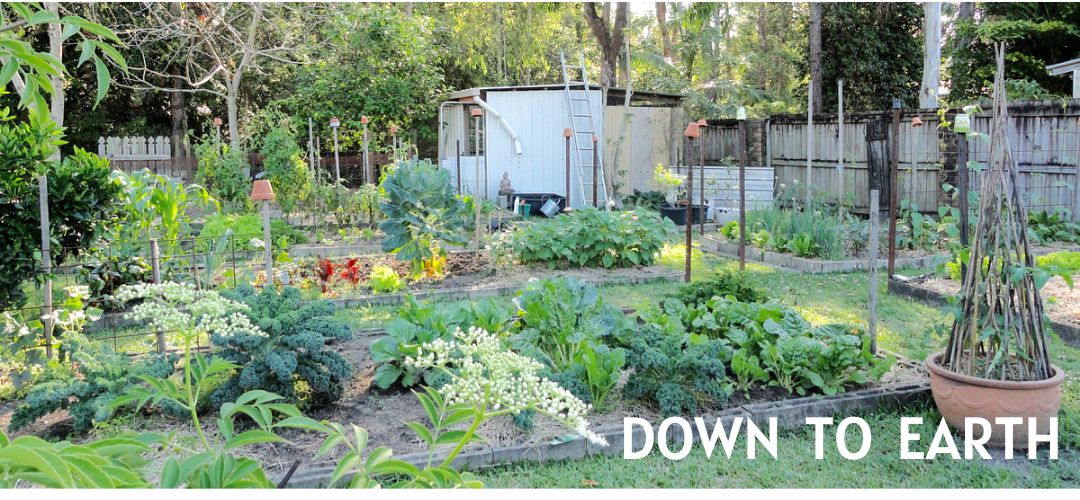In the photo below you can see the small cement slab running from the shed to the gate. This is the area we're enlarging. There will soon be a roof and walls surrounding the cement slab which will enable us to house about 20 chooks.
The coop is made up of a small shed where the girls sleep and lay their eggs. Just outside there is a fenced area that we're currently using as a pen to keep the older of the new chooks. This pen opens up to a larger run, just at the back of the vegetable garden, that is shaded by a fig tree, a lemon tree and a pecan. There is a lot of room for the girls to scratch and wander in the larger area but most days we open the gate and let them free range in the back yard. Often they'll wander through the fence and go down to the creek, or, during summer, they'll have their dust bath under the palm trees and then sit quietly in the shade.
We will keep the older new girls in this pen for two weeks. Then they'll know this yard is their home and even when they wander outside the confines of the fences, they'll know to come home at night. By then the four babies that we now have in a 200 litre plastic tub, will be big enough to go into the coop with their older sisters. They'll be kept in the pen for two weeks as well, to familiarise themselves with the other chickens while being separate from them, as well as seeing and feeling that this is their home. After their time in the outside pen, they'll be allowed out with the others. By then it will be time to bring our new Wyandotte babies home and they'll go through the same routine.
Yesterday afternoon, while Hanno worked on the roof, I was busy in the bush house, potting on the brandywine tomatoes. The photo above shows them a couple of weeks ago when the seedlings where starting to get their true leaves. I have found that tomatoes really benefit from special treatment before planting in the garden, so when I have the time, and when I want to make sure I get enough tomatoes to sink a ship, I go through the following procedure.
Each of the seeds is planted in a single long pot. I like these long pots as they encourage the roots to form and grow straight down. I do have two seeds in one pot above, but that's the result of my poor eyesight, or carelessness. After the seeds are planted they're put into a sheltered position that gets sun but no wind; I also put them into a container so they don't fall over.
Tomatoes have the ability to produce more roots further up their stem, and to encourage them to develop those roots, I plant them deeper into the potting soil than I normally would with other vegetable seedlings. Bury the stem a good two inches lower than it was in the previous pot, firm the potting mix and water in with diluted weak seaweed mix. This helps the seedling cope with transplant stress. If there are any leaves touching the soil, pick them off, carefully.
The lower in you plant the seedling, the more roots will develop. The more roots you have on the plant, the bigger it will grow, giving you more tomatoes. I planted these on yesterday, next week I'll fertilise them with a week compost tea (you can use any weak nitrogen fertiliser) plus a pinch of sulphate of potash, then I'll wait for them to produce flowers. When I see the flowers, I'll plant them in the garden.
When I plant the seeds, they don't need sunlight. When the seedling emerge and put on leaves, they need sunlight, so they're left to grow in a sunny spot out of the wind. After potting on, they go back to their sunny position, and then to the garden.
Never let your seedlings dry out. There is a fine line to be drawn between too much, and too little, water. You'll develop the feeling for watering as you gain experience, but when you're unsure, feel the potting mix with your fingers and if it's dry, water, if it's moist, wait another day.
Later this morning I'll be planting more seeds and fertilising the seedlings already in the garden. Now is the time when there are a lot of small and fiddly jobs in the garden but I know that if I tend to them all they will make a big difference to our harvests later in the year.
I hope you are having a lovely Easter. Thank you for stopping by and reading. For all those folk who have emailed in the past week or two, I hope to reply this afternoon. Thank you for your patience. : - )






